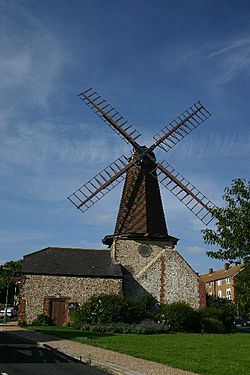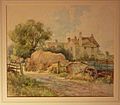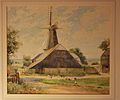West Blatchington Windmill facts for kids
Quick facts for kids West Blatchington Windmill |
|
|---|---|

The mill in 2002
|
|
| Origin | |
| Mill name | West Blatchington Mill |
| Mill location | TQ 279 068 |
| Coordinates | 50°50′49″N 0°11′06″W / 50.847°N 0.185°W |
| Operator(s) | Friends of Blatchington Windmill |
| Year built | c1820 |
| Information | |
| Purpose | Corn mill |
| Type | Smock mill |
| Storeys | Three-storey smock |
| Base storeys | Three-storey base |
| Smock sides | Six sides |
| No. of sails | Four sails |
| Type of sails | Patent sails |
| Windshaft | Cast iron |
| Winding | Fantail |
| No. of pairs of millstones | Two pairs |
West Blatchington Windmill is a special old windmill in West Blatchington, near Brighton and Hove, England. It is a Grade II* listed building, which means it's very important and protected. This type of windmill is called a smock mill. It has been carefully fixed up and is now open for people to visit and learn about.
History of the Windmill
When Was the Mill Built?
The West Blatchington Windmill was built around the 1820s. It first appeared on a map made by Greenwood in 1823. A famous painter named John Constable even painted the windmill in 1825.
Why Is This Mill Special?
Most smock mills have eight sides, making them look like an octagon. However, West Blatchington Windmill is different. It has only six sides, making it a hexagon. This makes it quite unique!
When Did the Mill Stop Working?
The windmill worked for many years, grinding corn, until 1897. At that time, two of its sails were damaged, and it could no longer operate.
Who Saved the Windmill?
In 1937, Hove Corporation bought the mill. They wanted to make sure this important landmark was saved. A company called Neve's, who were experts in fixing mills, did repairs in 1937.
Protecting the Windmill
The windmill was officially listed as a Grade II* building on March 24, 1950. This means it is a building of special historical interest. As of February 2001, it was one of many protected buildings in the city of Brighton and Hove.
How the Windmill Works
What Kind of Mill Is It?
West Blatchington Windmill is a three-storey smock mill. It sits on a strong three-storey brick base. There is also a platform, or "stage," at the third-floor level.
The Sails and How They Turn
When it was first built, the mill had four "Common sails." These were simple sails. Later, it was changed to use four "Patent sails." These sails were more advanced and could adjust themselves to the wind.
The sails were connected to a strong cast-iron "Windshaft." This shaft helped transfer the power from the wind. The mill also had a special "Holloway's screw brake" to stop the sails.
The Cap and Fantail
The top part of the windmill is called the "cap." It is shaped in a style common in Kent. A "fantail" on the back of the cap helped turn the cap automatically. This kept the sails facing the wind.
Grinding the Corn
Inside, the windmill used two pairs of "underdrift millstones." These large stones would grind the corn into flour. Most of the original machinery was removed in 1937. However, the "Brake Wheel" and "Upright Shaft" still remain.
The Mill and Its Barns
The windmill stood near three barns. One of these original barns is still standing today. Another barn was replaced with a new one in 1997.
Millers Who Worked Here
Many people worked at the West Blatchington Windmill over the years. Here are some of the millers who operated it:
- Hodson - 1887
- John Brown - 1887
- Whittington - 1897
Images for kids
These four watercolours were painted in 1937 by R Jameson. At that time, the mill was on a farm run by Arthur and Helen Paul.




